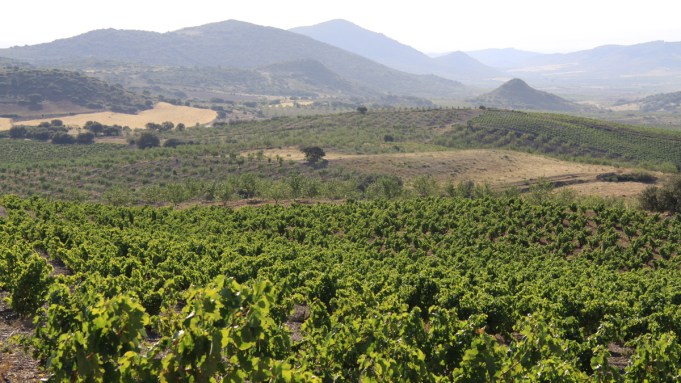Although it’s long been thought that Grenache is at its best in hot, dry climates that enable it to concentrate its sugars to their fullest, some of the best versions we have come across lately are from higher altitude regions that help to maintain acidity and freshness. When planted at low elevations the varietal can yield unmitigated fruit bombs, but when it is grown at heights beyond 1,600 feet, the cooler temperatures, especially after sunset, provides the best environment to cultivate high-quality, elegant Grenache.
A native of Spain, where it’s known as Garnacha, this grape is widely planted there as well as in southern France, Sardinia, Australia, Chile, South Africa, and the U.S.—especially California. Its prominence in Spain combined with the heights of many of the country’s mountainous wine regions makes it a top choice for some of the best bottles of Grenache. At altitude the true aromatics of the variety are released, offering floral, black pepper, and spice notes on the nose that carry over onto the palate.
Some of the best Garnacha in Spain comes from the autonomous community of Aragon in the northern part of the country, said to be the birthplace of the variety. Two of the finest regions for the grape within Aragon are Calatayud and Campo de Borja, which are covered with a patchwork of small vineyards bordered by forest and scrub. Case in point, Calatayud’s Cuevas de Arom, which produces Garnacha at four different levels including a regional wine, a village wine, and two single-vineyard offerings, specifically Ladieras and Tuca Negra; the latter fetches $150 a bottle and the 2020 and 2021 vintages each received 97 points from Robert Parker’s Wine Advocate. The grapes for Tuca Negra are grown on vines with greater than 50 years of age planted in sandy soils with slate and quartz at an altitude of 2,800 feet.
“The altitude plays a vital role in this arid and dry area,” says Aiyana Vilimek of Cuevas de Arom. “The temperature drop at night, which is more remarkable in higher altitude spots, keeps the ripening period slower as it retains the acidity. We can also harvest the grapes with lower alcohol levels and interesting fruit profiles, in order to achieve more balanced styles.” She describes the winery’s Garnacha from her vineyards closer to sea level as “fruitier and simpler,” which are common descriptors for Garnacha or Grenache from low-lying plots.
A selection bottles from high altitude.
Bodegas Alto Moncayo in Campo de Borja specializes in Garnacha from vineyards that range from 1,300 to almost 3,000 feet; its top wine is Aquilón, which goes for $200 and has scored very highly as well. Winemaker Miguel Sanmartín explains that a variety of parcels allows the team to pick at the perfect moment so he and vineyard manager José Luis Chueca can harvest the sites at “their absolute pinnacle.” Sanmartín tells Robb Report that in addition to altitude, the area is blessed with a wind known as Cierzo, a dry, strong, cold wind that blows more than 200 days per year from the north and northwest. The wind “drops temperatures at night and almost eliminates the need of using insecticides and pesticides, making the wines naturally organic,” Sanmartín says. And he adds that the strong day-to-night temperature shift offered by soaring vineyards maintains acidity while “providing a bright freshness and complexity to the wine.”
The wine regions closest to Barcelona, including Priorat and Monsant, are also a source of incredible Spanish Garnacha, such as Terroir al Limit Les Manyes, a $400 bottle made by German-born winemaker Dominik Huber in partnership with South African vintner Eben Sadie. The Les Manyes vineyard is planted above 2,600 feet with a clone called Garnatxa Peluda (hairy Garnacha) and is biodynamically farmed. Head enologist Tatjana Peceric credits the plot’s chalk and clay soils for adding minerality to the wine, while the elevation prevents overripening and enhances freshness. They stand in contrast to her Garnacha from lower areas that she says have less spiciness and complexity. Other Spanish bottles worth seeking out are the highly lauded Comando G Rozas 1er Cru from Sierra de Gredos, a high-flying but under the radar region near Madrid, and Terroir Sense Fronteres Marcenca from Monsant, also made by Huber and Peceric
Across the border in France, Chêne Bleu Abélard ($105) is made with 80 percent Grenache grown at 1,800 feet, one of the highest elevations in the southern Rhône, blended with 20 percent Syrah. At this altitude, the vineyards benefit from day-to-night temperature shifts, cooling winds, and a drawn-out growing season, all of which keep alcohol levels in check, according to Nicole Rolet. There’s “a high-alcohol palate-burning sensation” that plagues Grenache grown closer to sea level, she says, but that’s certainly not the case at her elevations.
Rolet sees higher altitude growing areas as the future of Grenache, especially in the face of unstable weather conditions and increased summer temperatures. “There is widespread recognition nowadays that these can offer ideal growing conditions for Grenache, especially as winemakers seek to reduce the runaway alcohol levels caused by global warming,” she says. “More and more winemakers are scouring the globe to find vineyards that have lots of sunshine for ripe fruit, but also the reprieve of cooling mountain influence.” The Southern Hemisphere is also home to its fair share of high-altitude Grenache, including Australia’s Clare and Barossa Valleys, whose top elevations are at the entry level of what are considered high altitudes, and Chile, where Viñedos Alcohuaz Cuesta Chica is made with Garnacha planted in the middle of the Andes Mountains at just shy of 6,900 feet above sea level. As winemakers seek higher ground to alleviate the effects of climate change, we may see more and more examples of graceful Grenache from mountainous regions around the globe, and we think that’s a good thing.


